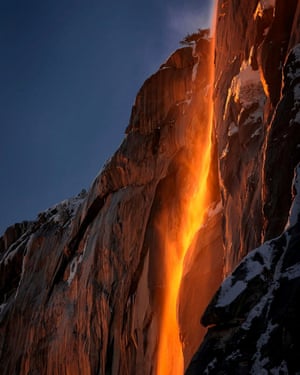Every February Horsetail Fall is lit by the setting sun, bringing thousands of people to Yosemite to watch the phenomenon

Aaron Meyer vividly remembers his first firefall. The spectacle of Yosemites famous Horsetail Fall lit up by the setting sun, which lasts for just a few minutes per night for a few weeks in late February, is sought out obsessively by photographers like him.
The clouds opened up just before sunset and it looked like someone had taken a match to the waterfall, you watched it go light up from top to bottom, he says of his first visit in 2011. Everyone erupted in cheers; it was the most amazing thing Id ever seen.
Back then, photographing the natural phenomenon was a guessing game. The firefall requires a convergence of forces: enough moisture to fuel the falls, skies clear enough for the light to shine through, and the right angle for the suns light to hit the 1000ft waterfall, east of El Capitan, for a dazzling display of color.
Soon after his first visit, Meyers, a trained engineer, built a computer program that could calculate the days that would have the best angle of the sun for optimal viewing, and published his recommendations on his blog.
For a couple of years no one seemed to notice until 2015, when someone shooting beside him pulled out a paper copy of his blogpost. It was like, people are actually using this, says Meyers, who spoke with the Guardian just before he left town for Yosemite.
Photographers are one of the reasons why the firefall has gotten so much buzz from the time Ansel Adams captured the falls in 1940 up to now. But in recent years the firefalls popularity has soared, boosted by social media and enthusiasts such as Meyers who have made capturing the phenomenon more accessible.

Paul Reiffer, a photographer from the UK, says he actually tries to avoid this time of year in Yosemite because the firefalls popularity has made it overwhelming. Reiffer says when he visited last year there were hundreds, if not thousands of people, jammed into the small areas ideal for viewing the falls.
It felt like an outside concert, with everyone and their picnic blanket trying to claim their spot. Reiffer says.Its crowded to the point where you are locking tripods with each other.
Reiffer also saw people leaving litter on the ground, breaking branches to get a better shot, and leaving the appointed area to walk down to the riverbank for a closer view, causing large amounts of erosion.
People forgot they were in Yosemite, in wilderness, which is really cool on its own, he says. Instead, they just focused on getting the perfect shot.
Its just a victim of its own success.
The park service says more than 2,200 people huddled to catch a glimpse of the falls on 22 February, the best day for viewing last year. The parks website describes visitors trampling sensitive vegetation, while areas became littered with trash, and the lack of restrooms resulted in unsanitary conditions.
In response to the crowds, the park service this year will close two of the ideal viewing areas, requiring everyone to walk 1.5 miles to the the third remaining one a step photographers call draconian.

The popularity doesnt deter everyone. Phil Hawkins, a Fresno-based photographer who has been visiting the falls for 37 years and teaches photo workshops in the park, says the party atmosphere is a positive. Everyone is happy, everyone is in a good mood, he says. People share equipment and food its a photography orgy.
The firefalls appearance this year could be in doubt, after a dry winter has left water levels in the park unseasonably low. Patrick Gonzalez, an environmental scientist at the University of California, Berkeley, who studies climate change and national parks, says the future of the firefall is uncertain.
Projections under continued climate change also show a mixed picture, with two-thirds of climate models projecting increased precipitation and the rest projecting decreases, Gonzalez says. And even if total precipitation increases, its not guaranteed that there will still be water; hotter temperatures due to climate change could increase evaporation and leave the park dry.
Gonzalez says that climate change has also been altering the park through droughts, bark beetle infestations and wildfires.
The photographers are seeing the changes on the ground, too. Up until three years ago, it was fairly reliable that youd have snow in February, spring conditions in June-July, and August would be dry, says Reiffer. But recently, he says, the seasons have become completely random.
Ironically, the climatic shifts may allow a second viewing of the freefall: in late October, theres another window of time where the suns angle hits the falls. Usually, theres no water then but its possible that there could be another opportunity to see the phenomenon if moisture comes later in the year.
Thats my backup plan, Reiffer says.
Read more: https://www.theguardian.com/us-news/2020/feb/17/yosemite-firefall-national-park-horsetail-fall


Recent Comments